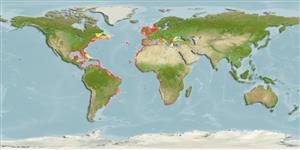>
Tetraodontiformes (Puffers and filefishes) >
Balistidae (Triggerfishes)
Etymology: Balistes: Latin, balista, -ae = crossbowman. In Greek, ballo = to throw (Ref. 45335); capriscus: Specific name 'capriscus' meaning a small goat; probably referring to its 'face' which looks like a small goat (to be confirmed)...
More on author: Gmelin.
Environment: milieu / climate zone / depth range / distribution range
экология
морской ассоциированный с рифами; пределы глубины 0 - 100 m (Ref. 7348), usually 0 - 55 m (Ref. 55172). Tropical; 58°N - 37°S, 98°W - 36°E
Western and Eastern Atlantic:
Length at first maturity / Size / Вес / Возраст
Maturity: Lm 17.0, range 13 - 29.7 cm
Max length : 66.0 cm TL самец/пол неопределен; (Ref. 127374); common length : 44.0 cm TL самец/пол неопределен; (Ref. 47377); наибольший вес (опубликованные данные): 6.2 kg (Ref. 40637); наибольший возраст (опубликованны данные): 15 годы (Ref. 107826)
колючие лучи спинного плавника (общее число) : 3; членистые (мягкие) лучи спинного плавника (общее число) : 26 - 29; колючие лучи анального плавника: 0; членистые (мягкие) лучи анального плавника: 23 - 26. Tall, with a small mouth and plate like scales (Ref. 35388). Three faint irregular broad dark bars on body; a narrow pale transverse band on chin; small light blue spots on upper half of body and median fins, and irregular short lines ventrally (Ref. 13442).
Inhabits bays, harbors, lagoons, and seaward reefs (Ref. 9710). May drift with young at surface among Sargassum (Ref. 9710). Usually solitary or in small groups (Ref. 9710). Feeds on benthic invertebrates like mollusks and crustaceans (Ref. 4727). Oviparous (Ref. 205). Consumed mostly fresh, smoked, and dried salted. The flesh is of excellent quality. Because it is resistant to capture, it proliferates and competes for food with other species (Ref. 5377).
Adults guard the embryos nested in sand which hatched in about two days (Ref. 9778).
Smith-Vaniz, W.F., B.B. Collette and B.E. Luckhurst, 1999. Fishes of Bermuda: history, zoogeography, annotated checklist, and identification keys. American Society of Ichthyologists and Herpetologists Special Publication No. 4. 424 p. (Ref. 35505)
Статус Красного Списка МСОП (Ref. 130435)
Угроза для людей
Reports of ciguatera poisoning (Ref. 30911)
Использование человеком
рыболовство: коммерческий; объект спортивного рыболовства: да; аквариум: общественные аквариумы
дополнительная информация
инструменты
Специальные отчеты
Скачать в формате XML
ресурсы в Интернет
Estimates based on models
Preferred temperature (Ref.
123201): 9 - 26.2, mean 17.8 °C (based on 1432 cells).
Phylogenetic diversity index (Ref.
82804): PD
50 = 0.5078 [Uniqueness, from 0.5 = low to 2.0 = high].
Bayesian length-weight: a=0.02089 (0.01769 - 0.02468), b=2.90 (2.85 - 2.95), in cm total length, based on LWR estimates for this species (Ref.
93245).
Trophic level (Ref.
69278): 4.1 ±0.2 se; based on diet studies.
Generation time: 4.0 (2.6 - 4.8) years. Estimated as median ln(3)/K based on 20
growth studies.
устойчивость к внешним воздействиям (Ref.
120179): средний (среднего размера), минимальное время удвоения популяции 1.4-4.4 года (K=0.18-0.43; tm=1).
Prior r = 0.37, 95% CL = 0.25 - 0.56, Based on 1 full stock assessment.
Fishing Vulnerability (Ref.
59153): Moderate to high vulnerability (46 of 100).
Climate Vulnerability (Ref.
125649): Low to moderate vulnerability (32 of 100).
Nutrients (Ref.
124155): Calcium = 17.4 [6.5, 68.9] mg/100g; Iron = 0.507 [0.242, 1.275] mg/100g; Protein = 19.7 [18.6, 20.8] %; Omega3 = 0.212 [0.146, 0.316] g/100g; Selenium = 21.2 [8.9, 47.8] μg/100g; VitaminA = 25 [6, 111] μg/100g; Zinc = 0.5 [0.3, 0.8] mg/100g (wet weight); based on
nutrient studies.
